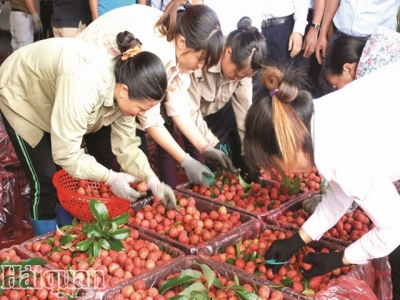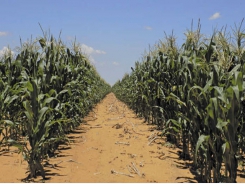Fruit and vegetable export: Beside acceleration is worrying

Entering the second quarter of 2019, Vietnam's fruit and vegetable exports recorded a remarkable improvement compared to the first months of the year. However, with many difficulties, especially in China, ensuring sustainable export growth of fruits and vegetables is not simple.
Vietnam still has plenty of room to promote fruit and vegetable exports. Photo: N.Thanh
Reversion
Over nearly half a year, exports of fruits and vegetables haveseen significant changes in a positive direction. If in the first threemonths of the year, total export value of fruits and vegetables reached 879 million USD, down 9.3% compared to the same period in 2018, by the end of May, the situation has reversed.
According to the latest report of the Department of Agricultural Product Processing and Development (Ministry of Agriculture and Rural Development), the export of fruits and vegetables in the first fivemonths of the year was estimated at 1.83 billion USD, up 10.3% over the same period in 2018. China ranked first for importing vegetables and fruits of Vietnam in the first fourmonths with 74.26% market share; followed by the United States accounting for 3.16%; South Korea accounted for 3.03%; and Japan accounted for 2.53%. Notably, the markets with high export value of fruits and vegetables increased Australia by 39.9%; Netherlands increased by 29.22%; South Korea increased by 25.53% and France increased by 24.81%.
Recently, Vietnamese fruit and vegetable exportsreceived quite satisfactory information. Typically, until April 18, the first mango batch of Vietnam exported to the US market with a volume of 8 tonnes. Mango has officially become Vietnam's sixth fresh fruit sent to the US market. This is the result of a tough 10-year negotiation process. To export mangoes firms have to ensure strict requirements of partners such as the content of pesticides, harmful insects, traceability and irradiation. Entering the US market has created more opportunities, not least for Vietnamese mangoes after this item has been exported to more than 40 countries around the world, including many fastidious markets such as Japan, Korea andAustralia.
For the Chinese market alone, the Department of Processing and Development of Agricultural Products Market has more information. At the end of April, China licensed to import Vietnamese mongosteen. This is the ninth fruit exported into this market . Particularly in the first fourmonths of this year, the value of imported vegetables and fruits of the Chinese market has increased to 3.1 billion USD, exceeding 26% over the same period last year; in which the fastest growth is mangosteen (up 600%). Forecast, in 2019 the Chinese market will import fruit with value exceeding 10 billion USD.
Change to meet requirements
In addition to the positive signals, the overall view of Vietnam's fruit and vegetable export story is full ofdifficulties set by the Chinese market.
According to Nguyen Quoc Toan, Director of the Agricultural Products Processing and Development Department, in recent years, China has introduced a series of regulations for Vietnamese agricultural products when exporting to this market. Currently, exporting fruit to China must meet technical requirements and regulations on food material safety; meeting China's food safety and plant quarantine regulations; the region code and place of agricultural products for this market must be register by China Customs. In addition, import units must clearly declare the origin of origin along with labels; the product must meet the technical requirements of packaging, hygienic conditions and haveno insect pests.Notably, China has had some changes in monitoring import and export of fruits into this country. Specifically, from October 1, 2019, food imported into China must have a food safety certificate issued by a competent authority for shipments. Some experts assess that, with the great dependence, any change from the Chinese market will significantly affect the export of vegetables and fruits of Vietnam, creating difficulties for the target of exporting vegetables.
In fact, considering on a large scale, Vietnam currently participates in the international fruit export market, accounting for 1.4 - 1.5% of the world's import value. The market is still very large. Therefore, relying less on the Chinese market, vegetables and fruits in Vietnam still have many opportunities to seek and promote export to other markets.
The problem of export of agricultural products in general, vegetables and fruits in particular, according to Tran Duy Dong-Director of the Domestic Market Department (Ministry of Industry and Trade) will be tackled byMinistry of Industry and Trade focuses on completing the trade infrastructure system to increase connectivity for goods circulation and reformingadministrative procedures, creatingmaximum advantages for trade, especially export and distribution of goods. "Enterprises and cooperatives in the process of agricultural production and trading must also meet the safe production process, ensuring sufficient product requirements of the imported side, contributing to boosting consumption of agricultural products to potential markets," Dong said.
Minister of Agriculture and Rural Development Nguyen Xuan Cuong:
In the context of the current international economic integration, the answer tosuccess is still to meet the high quality requirements of not only the Chinese market but for any market, so it is necessary to change to meet the requirements set by the market
Related news
Tools

Phối trộn thức ăn chăn nuôi

Pha dung dịch thủy canh

Định mức cho tôm ăn

Phối trộn phân bón NPK

Xác định tỷ lệ tôm sống

Chuyển đổi đơn vị phân bón

Xác định công suất sục khí

Chuyển đổi đơn vị tôm

Tính diện tích nhà kính

Tính thể tích ao



 Diesel tree: fuel for the alternative energy sector
Diesel tree: fuel for the alternative energy sector  Vietnam’s exports to Algeria decline over five-month period
Vietnam’s exports to Algeria decline over five-month period